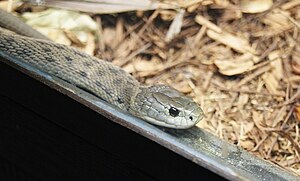Scale otter
| Scale otter | ||||||||||||
|---|---|---|---|---|---|---|---|---|---|---|---|---|

Scale otter ( Tropidechis carinatus ) |
||||||||||||
| Systematics | ||||||||||||
|
||||||||||||
| Scientific name of the genus | ||||||||||||
| Tropidechis | ||||||||||||
| Günther , 1863 | ||||||||||||
| Scientific name of the species | ||||||||||||
| Tropidechis carinatus | ||||||||||||
| ( Krefft , 1863) |
The Rauschuppenotter ( Tropidechis carinatus , Syn. : Hoplocephalus carinatus ) is a snake of the family of poisonous snakes (Elapidae). The genus Tropidechis is monotypical, so the rough scale otter is the only species in the genus. In English, the species is called " rough-scaled snake ".
features
The rough scale otter has a slim but strong build and reaches a length of 75 to 100 centimeters. The head separates from the neck. The body color varies between olive-green and dark brown. As a rule, there are several rows of dark spots along the back. The middle of the body is surrounded by 23 rows of scales, which are keeled and make the snake's skin appear rough. The eye has a round pupil when exposed to light . As is typical for poisonous snakes, the rough scale otter has fixed, immobile fangs in the anterior upper jaw that are connected to poison glands in the lateral skull area via a venom canal .
Occurrence
Tropidechis carinatus is distributed in the coastal east of Australia in the northeast of New South Wales as well as in the southeast and with a separate population in the northeast of Queensland . There are tropical rainforests and moist deciduous forests, inhabited.
Way of life
The rough scale otter leads a soil-dwelling way of life. However, it sometimes climbs in low bushes while searching for food. The range of prey includes small mammals , frogs , birds and lizards . The propagation is done by ovoviviparity , the species is so egg-viviparous. A litter consists of 5 to 18 young snakes.
The snake is shy and flees when threatened, but defends itself in distress.
toxicology
The poison bite of the scale otter is considered dangerous. The toxin mixture has various components. Of clinical relevance are particularly pre- and postsynaptic neurotoxins (inhibition of the cholinergic system through antagonism or inhibition of the release of acetylcholine in the synaptic cleft ) and Myotoxine and procoagulants . The latter can cause consumption coagulopathy .
Intoxication
Local symptoms such as pain, redness and swelling may occur after a bite. Non-specific systemic symptoms include nausea , vomiting, and abdominal pain . Consumption coagulopathy occurs very frequently and accordingly severe internal and external hemorrhages and hematuria can occur. The blood loss can be life threatening. Neurotoxicity (symptoms of paralysis) is usually mild, but severe paralysis with respiratory paralysis can still occur. Mild to moderate myolysis can cause secondary damage to the kidneys .
If left untreated, the mortality rate is 40 to 50 percent. Antiveningabe (Tiger Snake Antivenom, CSL Limited) has proven to be effective.
swell
- Gerry Swan: A photographic Guide to Snakes & other reptiles of Australia , The Australian Museum, New Holland Publishers, 1996.
- M. Gan, MA O'Leary, SG Brown, T. Jacoby, D. Spain, A. Tankel, C. Gavaghan, P. Garrett, GK Isbister: Envenoming by the rough-scaled snake (Tropidechis carinatus): a series of confirmed cases. In: The Medical journal of Australia. Volume 191, Number 3, August 2009, pp. 183-186, PMID 19645653 .
- WCH Clinical Toxinology Resources: Tropidechis carinatus (accessed March 10, 2015)